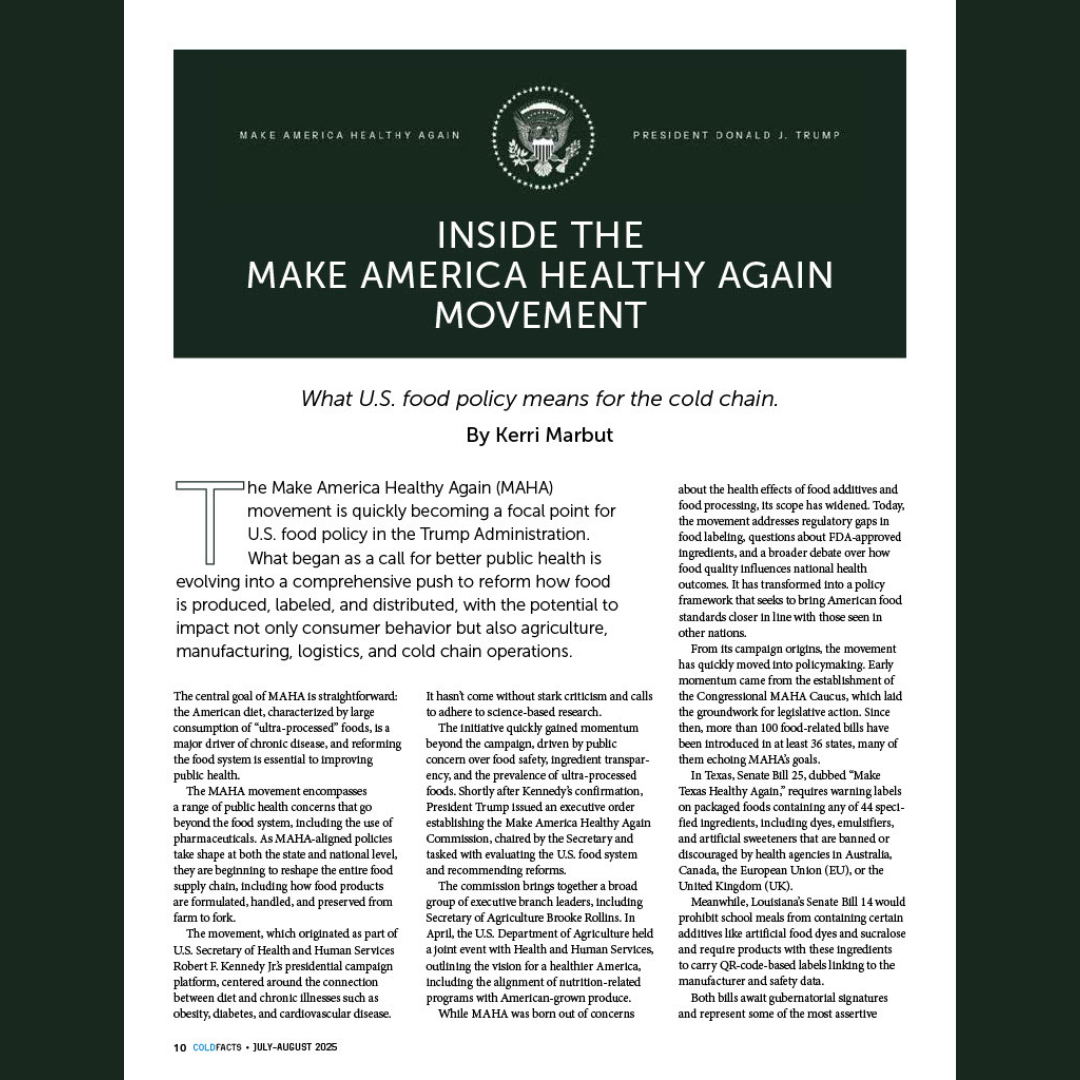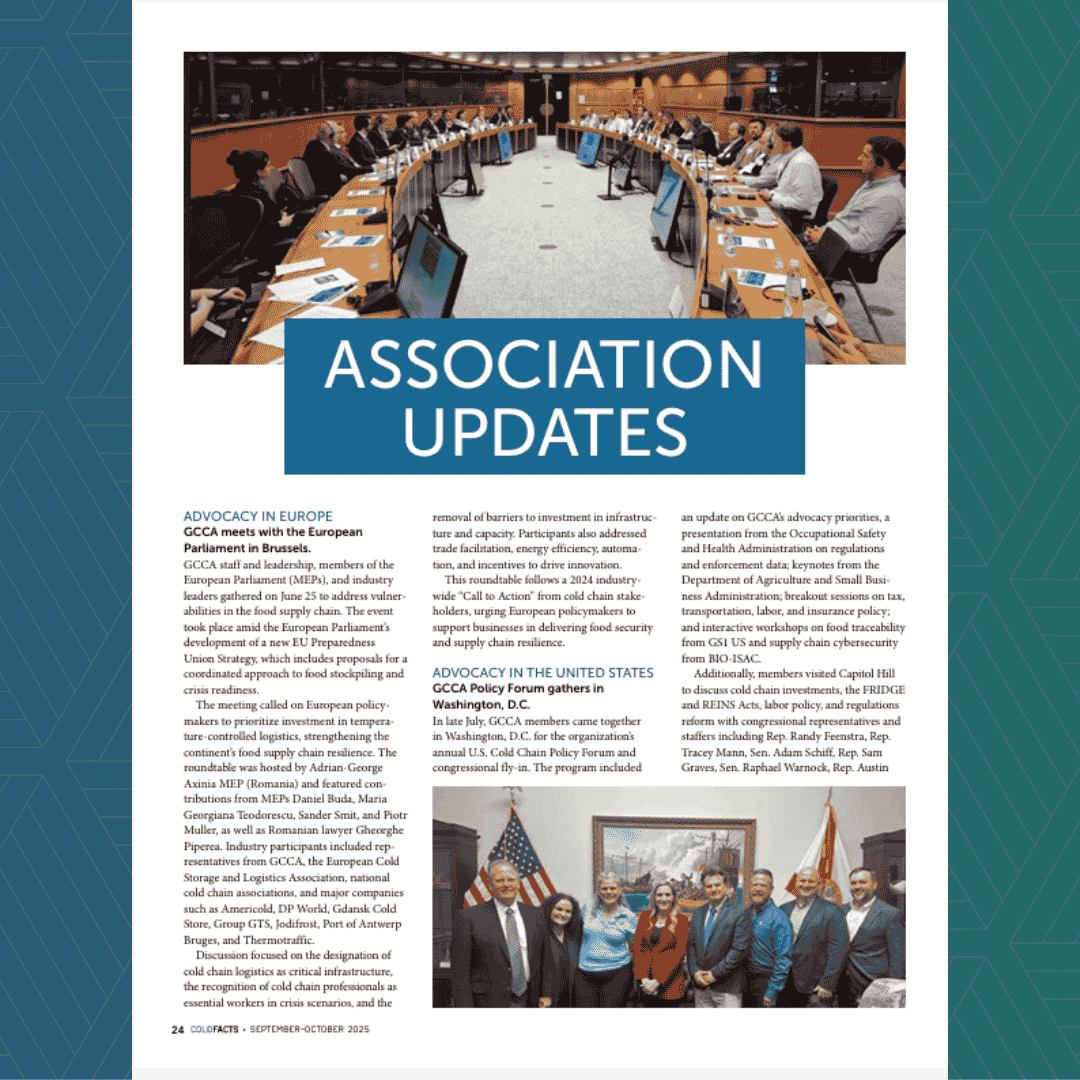What U.S. Food Policy Means for the Cold Chain
The Make America Healthy Again (MAHA) movement is quickly becoming a focal point for U.S. food policy in the Trump Administration. What began as a call for better public health is evolving into a comprehensive push to reform how food is produced, labeled, and distributed, with the potential to impact not only consumer behavior but also agriculture, manufacturing, logistics, and cold chain operations.
The central goal of MAHA is straightforward: the American diet, characterized by large consumption of “ultra-processed” foods, is a major driver of chronic disease, and reforming the food system is essential to improving public health.
From Public Health Concern to National Policy
The MAHA movement encompasses a range of public health concerns that go beyond the food system, including the use of pharmaceuticals. As MAHA-aligned policies take shape at both the state and national level, they are beginning to reshape the entire food supply chain, including how food products are formulated, handled, and preserved from farm to fork.
The movement, which originated as part of U.S. Secretary of Health and Human Services Robert F. Kennedy Jr.’s presidential campaign platform, centered around the connection between diet and chronic illnesses such as obesity, diabetes, and cardiovascular disease. It hasn’t come without stark criticism and calls to adhere to science-based research.
The initiative quickly gained momentum beyond the campaign, driven by public concern over food safety, ingredient transparency, and the prevalence of ultra-processed foods. Shortly after Kennedy’s confirmation, President Trump issued an executive order establishing the Make America Healthy Again Commission, chaired by the Secretary and tasked with evaluating the U.S. food system and recommending reforms.
The commission brings together a broad group of executive branch leaders, including Secretary of Agriculture Brooke Rollins. In April, the U.S. Department of Agriculture held a joint event with Health and Human Services, outlining the vision for a healthier America, including the alignment of nutrition-related programs with American-grown produce.
While MAHA was born out of concerns about the health effects of food additives and food processing, its scope has widened. Today, the movement addresses regulatory gaps in food labeling, questions about FDA-approved ingredients, and a broader debate over how food quality influences national health outcomes. It has transformed into a policy framework that seeks to bring American food standards closer in line with those seen in other nations.
The Ripple Effect: How State-Level Action is Forcing Change
From its campaign origins, the movement has quickly moved into policymaking. Early momentum came from the establishment of the Congressional MAHA Caucus, which laid the groundwork for legislative action. Since then, more than 100 food-related bills have been introduced in at least 36 states, many of them echoing MAHA’s goals.
In Texas, Senate Bill 25, dubbed “Make Texas Healthy Again,” requires warning labels on packaged foods containing any of 44 specified ingredients, including dyes, emulsifiers, and artificial sweeteners that are banned or discouraged by health agencies in Australia, Canada, the European Union (EU), or the United Kingdom (UK).
Meanwhile, Louisiana’s Senate Bill 14 would prohibit school meals from containing certain additives like artificial food dyes and sucralose and require products with these ingredients to carry QR-code-based labels linking to the manufacturer and safety data.
Both bills await gubernatorial signatures and represent some of the most assertive MAHA-aligned measures to date.
Globally, MAHA-style regulations are not a new concept. The E.U. bans several dyes and preservatives that are found in U.S. foods and Canada requires clear front-of-pack warnings for products high in sodium, sugar, or saturated fat.
The Food and Drug Administration banned Red Dye 3 in January, shortly before President Trump took office, and in April announced a plan to phase out petroleum based dyes, targeting Red Dye 40, Yellow Dye 5, Yellow Dye 6, Blue Dye 1, Blue Dye 2, and Green Dye 2. The food industry is already witnessing shifts in the use of artificial and petroleum-based dyes, with the Kraft Heinz food company announcing in June that it will remove all artificial dyes from its products by 2027 and will not launch any new products that utilize artificial coloring.
The Critical Impact: Why MAHA Makes the Cold Chain Non-Negotiable
As MAHA-inspired reforms push food manufacturers to eliminate synthetic preservatives, artificial dyes, and other chemical additives, the role of cold storage and refrigerated transport becomes even more critical. Without certain additives, many foods have shorter shelf lives and greater sensitivity to temperature and handling conditions, which could lead to an increased reliance on cold chain infrastructure to preserve freshness, extend usability, and maintain food safety.
At the same time, there is a shift in consumer demand toward fresh foods, which can be best achieved through the use of the cold chain. The cold chain is essential to meeting this demand, ensuring that perishable items are safely delivered to consumers.
While much remains uncertain, the direction of change is clear: food is becoming a central focus of public health policy. What lies ahead could be a complex environment, but also one rich with opportunity for the cold chain. As demand rises for fresh and minimally processed foods, the cold chain industry stands poised to play an increasingly vital role in America’s food system.
Media Contact
For media inquiries, please contact: Lindsay Shelton-Gross, Senior Vice President, Global Communications, Marketing and Strategic Initiatives, Global Cold Chain Alliance.




